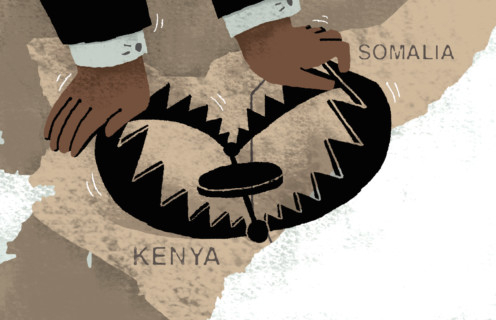
On April 1, life was normal for the close to 800 students of a university college in the remote part of Kenya’s north-east, which borders Somalia. And then, at dawn the next day, all hell broke lose: Masked gunmen stormed the fortified campus dormitories shooting indiscriminately at the fleeing students before taking several hundred hostages. The dawn-to-dusk siege ended when the four gunmen detonated their suicide vests, with a fifth arrested. The attack left at least 147 people dead, mostly students, with survivors afterward recounting how the militants singled out and executed Christians.
It is the deadliest attack yet by Al Shabab, the Al Qaida-affiliated Somali militant group, which declared war on Kenya after the country sent its troops into Somalia in 2011. In a similar attack in 2013, armed gunmen stormed the Westgate shopping complex in Nairobi, selectively killing Christians and taking many people hostage. By the time the guns fell silent three days later close to 70 people had been killed.
The attacks have raised fundamental questions about Kenya’s security strategy. Recent commentary has emphasised the toxic mix of corruption and the structural alienation of Kenya’s Muslim population. Immigration and police officials, it is argued, can be bought by the highest bidder. Recently there have been widely publicised accounts of how foreigners have managed to acquire Kenyan passports within a few weeks of sneaking into the country. This corruption has played into the hands of both Al Shabab and the Mombasa Republican Council (MRC), a secessionist outfit in the country’s coastal regions, with both capitalising on popular disenchantment of the Kenyan Muslim minority for their recruitment.
Following the attacks, it took security services several hours to arrive at the site of the siege because of bad roads in the area. Neglect by successive administrations has ensured that Garissa, like most of Kenya’s north-east, is part of Kenya by name only: before the attack, the local leadership had given the government an ultimatum: either ensure security or allow locals to take up arms to defend themselves from threats that range from Al Shabab attacks to cattle rustling and inter-clan warfare.
Untold story
Thus, while the story of Kenya’s struggle with terrorism has been dominated by images of urban sieges, the untold story was the insecurity and neglect that the people of north-eastern Kenya have had to endure for decades. The country may have won international acclaim for major investments in infrastructure, but it is not lost on locals that the whole region bordering Somalia has less than 100 miles of tarmacked roads.
This inconvenient truth, while not by it self-sufficient to account for terrorism, should inform the way the country understands and respond to threats to its security. The attacks should also bring to the forefront of Kenya’s national debate on terrorism the role of societal strains. The victims will have been targeted because of a perception of their role in a dominant framework of power. To mount such a deadly attack, Al Shabab will have relied on local accomplices, buttressed by a framework of clan and/or religious ideology.
Understanding this “grievance” framework of terrorism is important but only the first step in an effective counter-terrorism strategy. The other aspect is to recalibrate the state’s material response. So far this has not happened. Local commentators have called on the state to bring out “bigger guns”, and to identify and eliminate “enemies within”. The current administration’s lack of a nuanced strategy doesn’t go much beyond rolling back civil liberties and using brute force. Other initiatives are more far-fetched — for example a proposed “separation wall” between Kenya and Somalia.
Suffice to say that Al Shabab has been effective precisely because it exploits Kenya’s blind spot, which results from this conventional thinking. Although Kenya has one of the highest military budgets in Africa, it has so far not been able to gain a sustained upper hand against what commentators refer to as a “rag tag militia”. Why? Let me propose something radical here: In order to suppress and defeat Al Shabab, Kenyan policy makers have to learn from them.
The Ethiopia example
Alongside a broad rethink of Kenya’s security strategy, the country should climb down from the cold-war logic of heavy expenditure on “force multipliers” (tanks, aircraft etc) and emphasise village-level flexibility and agility, which has greater per capita return. Per annum military expenditure should be informed by the new threat of Islamist terrorism, emphasising development of rapidly deployable cells of Muslim or Somali-speaking infantry with a broad mandate to intervene against breaches of the country’s security laws.
The reason neighbouring Ethiopia has been effective in responding to Al Shabab is that, unlike Kenya, it has decentralised risk assessment and security decision-making. Cells of well-trained Kenyan-Somalis, anchored by a large deployment of the KDF along the Somali border, would for example be more effective than the corrupt Kenyan police.
If Al Shabab has been effective against armies, it is because it can identify and recruit Somalis who can fight for a fraction of the budget. Kenya needs to out-recruit Al Shabab, paying more and offering inducements to those who want to be on the right side of history. This will also give it the intelligence advantage it badly needs.
But here is the problem: Kenya, like African nations generally, assesses its threats from the essentialist perspective of the western states that train their armies. This logic sees recruitment of Somali young men by radical elements as an aspect of their religion or race only — irrespective of other factors such as monetary inducements. In order to survive and thrive, however, a reassessment of this logic is urgent and necessary.
— Guardian News & Media Ltd
Mwenda Kailemia is a lecturer in Criminology at Keele University. He studied Political Science and Philosophy at the University of Nairobi.









